![]()
![]()
![]()
Use LEFT and RIGHT arrow keys to navigate between flashcards;
Use UP and DOWN arrow keys to flip the card;
H to show hint;
A reads text to speech;
22 Cards in this Set
- Front
- Back
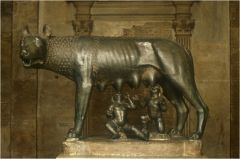
|
Title: She Wolf
Artist: Etruscan Period Period: Roman Art Date: 500 BCE Significance: - the twin brothers were said to have been left to die by the Tiber River - She wolf discovered them and took them in - when they reached adulthood, they build a city near the spot where they were found by the shewolf - this may not be the acutal sculpture, original one was said to have been struck by lightning |
|
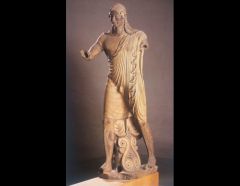
|
title: Apollo
artist/culture: roman date: 500 BCE period: Etruscan Significance: - made out of terracotta which is hard because it may collapse on its self when the clay is wet - may have been created at the workshop of well know sculptor called Vulca - from the temple dedicated to Minerva |
|

|
title: burial chamber
artist/culture: Rome date: 3rd century BCE period: Etruscan Significance: - flat cilings to resemble rooms in houses - walls painted and rooms fully furnished |
|

|
title: sarcrophagus from cerveteri
artist/culture: Rome date: 520 BCE period: Etruscan Significance: - made from terracotta - artist protray the individual in the urn at the height of their lives. |
|
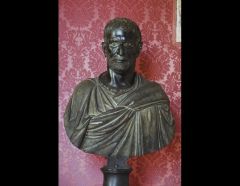
|
title: head of a man
artist/culture: roman date: 3rd century BCE period:Etruscan Significance: - was said to be of the founder and first consul of the Roman Republic - the features allow us to believe that he is of importance |
|
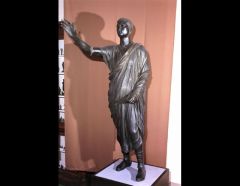
|
title: aulus metellus
artist/culture: Roman date: 80 BCE period:republican period Significance: - they admired realistic portrayals. - placed atop of columns as memorials |
|
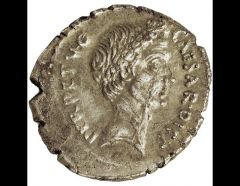
|
title: denarius with portrait of julius ceasar
artist/culture: roman date: 44bce period:republic Significance: - propaganda - still showing the realistic art - Venus was placed on the other side because Caesar claims to have been a descendant from Venus. |
|

|
title: Point du gard
artist/culture: Roman date: 1st century BCE period: emperial Significance: - this carried the water water across the bridge of arches - used gravity flow to bring water from 30 miles away |
|

|
title: temple, dedicated to portunus
artist/culture: roman date: late 2nd bce period: empiral Significance: - shows the roman architecure where the colums are engaged to the cella (greek: not engaged, free standing) - still had the porch and one stairway like the greek |
|

|
significance:
- Octavius took over and lead the "roman peace" - he had the best qualities: system of law, governmental and administrative skills and sophisticated civil engineering and architectural systems |
|
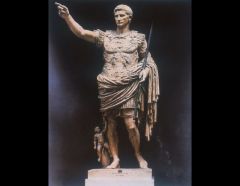
|
title: augustus of primatora
artist/culture: Augustan period:early empire date: 20 bce significance: - roman form of idealism and use of propaganda - the posture of ulus metellus and ideal porportions of the spear bearer of the greek - and also added mythological imagery. its the cupid. son of the goddess venus. ads to the claim that he was a decent from the goddess Venus. - the bare feet suggest to scholars that his elevation to divine status after death. too good for shoes |
|
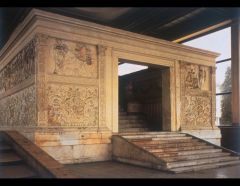
|
title: altar of augustan peace
artist/culture: early empire period:Augustan period date: 9BCE significance: - this was dedicated to commemorate his triumphant reutrn to roam after he ruled Faul and Hispania. - the decoration embodies a unification of people. kids to elderly - there are carvings of plants from everyseason embodying the continuous peace - the people in the front are at higher relief than the back, and their feet are the most reliefed, allowing an illusion that the viewer is also in the group |
|
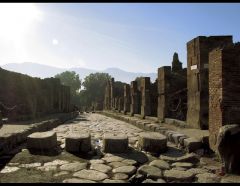
|
title: street in pompeii
artist/culture:roman period: early empire date: early 2nd centuary significance: - they emphasized the interior more than the exterior |
|
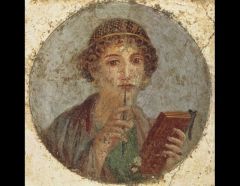
|
title: young woman writing
artist/culture: roman period: early empire date: 1st centuary significance: - woman may be idealized - educated women were liked |
|

|
title: arch of titus
artist/culture: roman period: empiral date: 70 bce significance: - honours the capture of jerusalem - one side is the "spoils from the temple of solomon": very messy, the menorah is of the highest relief - the other side is: triumphal procession, titus in chariot: the horses are aligned and neat and organized with titus on the top |
|

|
title: colosseum
artist/culture: rome period: imperial date: 70 BCE significance: - sports arena th had fights between 2 gladiators, or one with a wild animal, - tunnels underneath heald the prisoners and animals - the seats were designed so people can only leave in a single file manner |
|
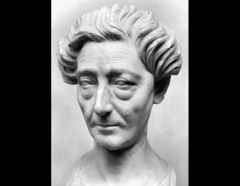
|
title: middle aged flavian woman
artist/culture: roman period: early empire date: late 1st centuary significance: - resembles the methods used in the republican period where they depict people realistically - her hair is in the latest style even though she doesnt care about her face |
|

|
title: pantheon
artist/culture: roman period:high empire date: 118 BCE significance: - temple to the Olympian gods - has a hole right in the center so who ever stands under the hole has a bright light beaming from the sky |
|

|
title: the unswept floor
artist/culture: sosos of pergamon period: date:2nd century significance: |
|
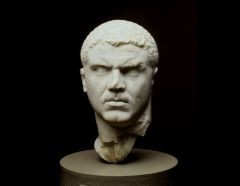
|
title: caracalla
artist/culture: roman period: high empirial date: 3rd century significance: - shows his ruthlessness - strong chisel work allows contrast of light and dark creating the chilling mood - you can tell the difference between his rule and augustus's |
|
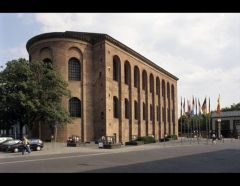
|
title: basilica
artist/culture: roman period: high emperial date: 4th century significance: - it is centurally heated with hot air flowing under the floor - windows create an optical effect, the windows in the hall are smaller than that of the end, so who ever sits at the end appears larger and more athority - |
|

|
title: arch of constatine
artist/culture:roman period:late antique date: 4th century significance: - has all the earlier values and virtues inorder to symbolize that all those are now in him. - rulers and the history are sperated and the styles of constuction are different therefore this brings together the art of classical world and the art of the middle ages. |

